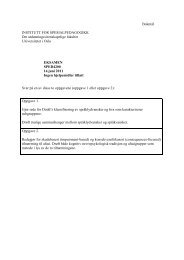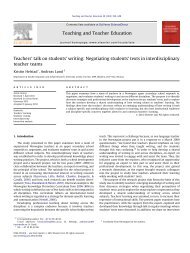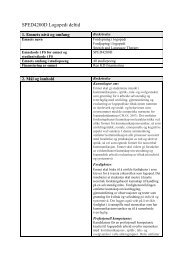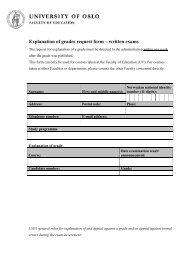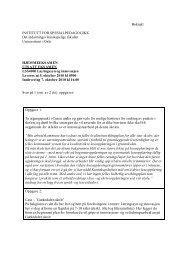International Journal Special Education
International Journal Special Education
International Journal Special Education
You also want an ePaper? Increase the reach of your titles
YUMPU automatically turns print PDFs into web optimized ePapers that Google loves.
INTERNATIONAL JOURNAL OF SPECIAL EDUCATION Vol 26, No: 3, 2011Barkley, R. A. (1998). Attention-deficit hyperactivity disorder. In E. J. Mash & R. A. Barkley (Eds.),Treatment of childhood disorder, 2nd ed. (pp. 55-110). New York, NY: Plenum Press, 55-110.Biederman, J., Mick, E., Faraone, S. V., Braaten, E., Doyle, A., Spencer, T., Wilens, T. E., Frazier, E., &Johnson, M. A. (2002). Influence of gender on attention deficit hyperactivity disorder in children referredto a psychiatric clinic. American <strong>Journal</strong> of Psychiatry, 159, 36-42.Boucher, C.R. (1986). Pragmatics: The meaning of verbal language in learning disabled and nondisabledboys. Learning Disability Quarterly, 9, 285-294.Bryan, T. H. (1982). Social skills of learning disabled children and youth: An overview. LearningDisability Quarterly, 5, 332-333.Bryan, T. (1997). Assessing the personal and social status of students with learning disabilities. LearningDisabilities Research and Practice, 12, 63–76.Cartledge, G., & Millburn, J. F. (1996). Cultural diversity and social skills instruction: Understandingethnic and gender differences. Champaign, IL: Research Press.Cartledge, G., Stupay, D., & Kaczala, C. (1986). Social Skills and Social Perception of LD andNonhandicapped Elementary-School Students. Learning Disability Quarterly, 9(3), 226-234.Faraone, S.V., Biederman, J., Monuteaux, M.C., Doyle, A. E., & Seidman, L.J. (2001). Learningdisabilities and executive dysfunction in boys with attention-deficit/hyperactivity disorder.Neuropsychology, 15(4), 544-556.Flicek, M. (1992). Social status of boys with both academic problems and attention-deficit hyperactivitydisorder. <strong>Journal</strong> of Abnormal Child Psychology, 20(4), 353-366.Forness, S.R., & Kavale, K.A. (1991). Social skills deficits as primary learning disabilities: A note onproblems with the ICLD diagnostic criteria. Learning Disabilities Research and Practice, 6, 44-49.Forness, S. R., & Kavale, K. A. (1996). Treating social skill deficits in children with learning disabilities:A meta-analysis of the research. Learning Disability Quarterly, 19, 2-14.Fusell, J. J., Macias, M. M., & Saylor, C. F. (2005). Social skills and behavior problems in children withdisabilities with and without siblings. Child Psychiatry and Human Development, 36(2), 227-241.Gresham, F. M. (1981). Assessment of children’s social skills. <strong>Journal</strong> of School Psychology, 19, 120–133.Gresham, F.M. (1988). Social competence and motivational characteristics of learning disabled students.In M. Wang, M. Reynolds, & H. Walber (Eds.), The handbook of special education: Research andpractice (pp. 283-302). Oxford, England: Pergammon Press.Guevremont, D. C., Dumas, M.C. (1994). Peer relationship problems and disruptive behavior disorders.<strong>Journal</strong> of Emotional and Behavioral Disorders, 2(3), 164-172.Guralnick, M.J. (2005). Early intervention for children with intellectual disabilities: Current knowledgeand future prospects. <strong>Journal</strong> of Applied Research in Intellectual Disabilities, 18, 313-324.Korn, E. L., & Graubard, B. I. (1999). Analysis of health surveys. New York: John Wiley and Sons, Inc.Kronick, D. (1978). An examination of the psychosocial aspects of learning disabled adolescents.Learning Disability Quarterly, 1, 86-93.Landau, S., & Moore, L. A. (1991). Social skill deficits in children with attention-deficit hyperactivitydisorder. School Psychology Review, 20(2), 235–251.Mayes, S. D., Calhoun, S. L., & Crowell, E. W. (2000). Learning disabilities and ADHD: Overlappingspectrum disorders. <strong>Journal</strong> of Learning Disabilities, 33(5), 417-424.Milne, A., & Plourde, L. (2006). Factors of a low-SES household: What aids academic achievement?<strong>Journal</strong> of Instructional Psychology, 33, 183-93.Nixon, E. (2001). The social competence of children with attention deficit hyperactivity disorder: Areview of the literature. Child Psychology & Psychiatry Review, 6, 172-179.Oliva, A. H., & La Greca, A. M. (1988). Children with learning disabilities: Social goals and strategies.<strong>Journal</strong> of Learning Disabilities, 21, 301-306.Osman, B. B. (1987). Promoting social acceptance of children with learning disabilities: An educationalresponsibility. Reading, Writing and Learning Disabilities, 3, 111-118.Parker, J. G., & Asher, S. R. (1987). Peer relations and later personal adjustment: Are low-acceptedchildren at risk? Psychological Bulletin, 102, 357-389.Pearl, R., Farmer, T. W., Van Acker, R., Rodkin, P., Bost, K. K., Coe, M., & Henley, W. (1998). Thesocial integration of students with mild disabilities in general education classrooms: Peer groupmembership and peer-assessed social behaviour. The Elementary School <strong>Journal</strong>, 99, 167–186.Rao, J. N. K., & Scott, A. J. (1987). On simple adjustments to chi-square tests with sample survey data.The Annals of Statistics, 15, 385-397.Reid, R., Riccio, C. A., Kessler, R. H., DuPaul, G. J., Power, T. J., Anastopoulos, A. D., Rogers-Adkinson, D., & Noll, M. (2000). Gender and ethnic differences in ADHD as assessed by behavior246





